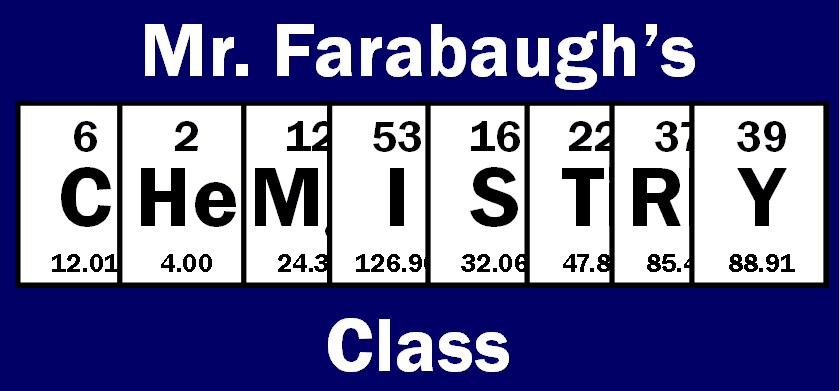Here is a brief look back at the week of August 29 - Sept 2.
AP Chemistry
I have completed our discussion of Chapters 1 and 2, and you should be working on your take-home test over the Labor Day weekend. E-mail me with questions. I expect to receive your completed test on the morning of Tuesday, September 6th.
At this point we have basically completed our discussion of Chapter 3 concepts, including mass-mole relationships and stoichiometry. I'll give you Chapter 3 practice problems on Wednesday and the Chapter 3 test will be coming soon.
Advanced Chemistry
Here is a summary of the activities from this week:
On Monday, we finished up the laboratory involving the density of colored liquids. We also finished reviewing the packet entitled
"Math Concepts Used in Chemistry." Then I gave a Math Assessment, which hopefully gave everyone a good idea of whether or not they should start coming to Mustang Morning for some math assistance.
On Tuesday, we looked at SOL Chemistry questions in the Scientific Investigation strand. If students would like to practice answering Chemistry SOL questions,
they can visit the Jefferson Lab website and select Chemistry.
When prompted for more options, you can select the "Scientific Investigation" strand.
On Tuesday students started taking notes from a PowerPoint slide show presentation entitled "Scientific Notation and Dimensional Analysis." This PowerPoint slide show
can be viewed on my website by clicking here, and
the handout for these notes can be found by clicking here.
On Wednesday, I gave students the opportunity to practice conversion problems using dimensional analysis. I explained that a conversion factor is a ratio that allows you to convert from one unit to another. Some problems have only one step, but other problems require 2 or 3 conversion factors. It is very important to write down the units during every step, so that you can clearly see how to cancel them out.
On Thursday, we did a measuring activity using small wooden or plastic blocks. The students learned that when a measurement is made with a ruler, the final digit is an estimated digit. This final digit can be a "zero" if the measurement is exactly on the line.We also discussed the concepts of precision, accuracy, significant figures, and graphing. The PowerPoint slide show for these notes
can be found on my website by clicking here, and
the handout for these notes can be found by clicking here.
On Friday, we did a lab activity using rubber stoppers. Students used the technique of water displacement to calculate the volume of the stoppers. Then they plotted their mass and volume data on a graph, as a way of determining the density. When mass is on the y-axis and volume is on the x-axis, the slope of the line equals density.
HOMEWORK: Students should study their notes completely. Then they should complete the Unit 1 Practice Test,
which can be found by clicking here. This practice test will be reviewed in class on Tuesday.
The Unit 1 Test will be on Wednesday. E-mail me with any questions. When you come to class on Tuesday, you should be well-rested and ready to learn! Have a great weekend.





